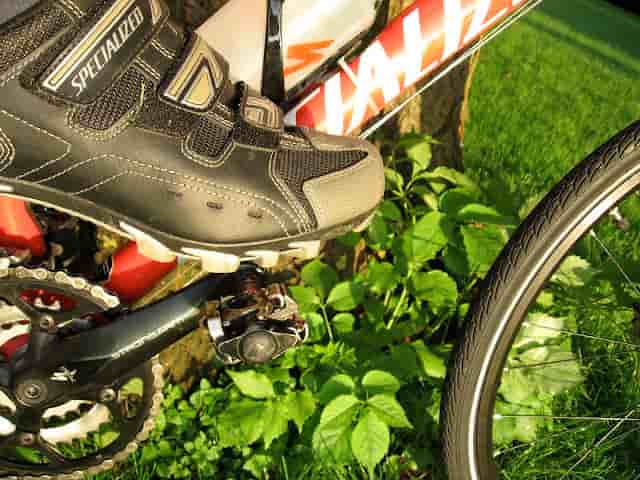Clipless pedals are great for enhancing your ride experience – but only when you’ve got the matching shoes.
Cycling cleats aren’t designed for normal wear, however, so you’ll sometimes be in a situation where you want to ride your bike without having the right shoes. Sometimes you’ll forget your shoes when you drive to the trail.
Other times you’ll just be in the mood for a spontaneous ride. Occasionally, you’ll be trying to ride someone else’s bike, or you’ll have sold your old cleats and you’re waiting for the new ones to arrive in the mail.
So what can you do? Can you still ride your bike? Here’s everything you need to know about how you can and should use your clippy pedals when you don’t have the proper shoes.
What is a Clipless Pedal?
A clipless pedal is an innovative pedal design that attaches the soles of your Clipless cycling shoes to the pedal. This device keeps the soles locked on the pedal all the time, and it does not let the foot slip off the pedal.
In simple terms its just like a mechanical device used to enhance the performance of your bike. By attaching your shoes firmly to the bike pedal it allows for efficient power transfer avoiding losses due to slip or poor contact.
With normal pedals you only apply force during half the swing when you put your feet pressing the pedal down. But when using clipless pedal your feet are locked into the pedals as you swing your pedals.
This allows to transfer force both during the up and down swing of your pedal; generating more speed for the same effort. There is primarly just two types of clipless systems, walkable Clipless systems and road Clipless systems.
The pedals that have a walkable Clipless system are ideal for off-road and century riding. The pedals that have a road Clipless system are suitable for bike hiking trials.
Clipless Pedals : Benefits & Limitation
Benefits
The Clipless pedal device will help a cyclist to ride their bicycle with ease and comfort. Naturally, there are several benefits of using a Clipless pedal. These Clipless pedals are lighter in weight compared to other types of pedals.
Some of the other advantages of using a Clipless pedal are preserving power and foot stability.
In terms of energy efficiency, you do not need to put additional power for pedaling because of the continuous cyclic momentum caused by the shoes clipped into the pedal all the time.
In terms of foot stability, the foot will never slip off the pedal.
Limitations
Ask any cyclist who has been using them for a while, they will let you know this product has its limitations. One of the major limitations of this device is that it is not versatile and convenient.
This device is not reliable in certain geographic terrains like hilly areas, deserts, and dirt roads. Further it has its own learning curve; which means it won’t be that comfortable and helpful from the start.
Further some cyclist don’t prefer to use them stating It’s is not suitable for hilly terrain because leg movement is restricted. So stopping your bike with your legs is not possible.
Nor did your legs automatically detach/separates from the pedal in event of an accident. You need to follow a particular set of steps to detach off your pedal; which is normally quite easy to do but feels hard during accidents.
Can You Use Clipless Pedals With Normal Shoes?
You can absolutely use clipless pedals with normal shoes. You will, however, run into some issues: clipls tend to be very small, very smooth, and have clips on one or both sides of the pedals.
This means that you’ll probably have a very uncomfortable cycling experience. There are a few things you can do to help mitigate these issues.
First, if you have pedals that only have clips on one side, flip them over so the clips are facing down. This will help prevent your shoe from getting torn up by the pointy bits of the clip.
Second, go slow. The harder you pedal, the more likely it is that your feet will slip. If your foot slips off the pedal there’s a very high chance that you’ll wind up hitting your shin against the pedal.
This isn’t pleasant in the best of circumstances, but the odds of injury go up when there are sharp clips protruding out of one side of the pedal.
Third, try to use stiff shoes. The small surface area of most clips means that there’s a lot of pressure being applied to a small part of your shoe.
Standard sneakers ( especially older sneakers ) don’t have the structural rigidity to deal with this in a comfortable way. This means that you’ll be essentially jamming the pedal into your foot the entire time you ride.

Clipless Pedals Aren’t All The Same
If you need to ride home and you forgot your cycling shoes, there might not be a lot you can do other than tough out the uncomfortable ride back home.
If you’re at home, however, there are plenty of options that you have to prevent this problem in the future. Even then sometimes you want a shoes that can fit well for multiple use while also good for riding your bike.
The simplest is to start by thinking about what kind of pedals you want on your bike.
Pedals come in many shapes, sizes, and styles. While some pedals strive to be small and light, others instead offer a simple solution to the shoe problem: they’ve got clips on one side and flat pedals on the other.
These hybrid pedals are a bit bigger and heavier than the smallest clips and have the downside of having to be spun to find the “correct” side. Still, they offer a permanent way to always have the right pair of shoes.
Adapters
If you’re not willing to swap out your pedals for hybrids, consider investigating adapter systems. Adapters are platforms that attach to your clipless pedals via the clip and provide you with suitable flat areas to ride on.
Think of them like flats that clip onto your clips. There are a handful of different adapters on the market, most notably Corki-15, Fly Pedals, and Rocket Pedals.
All three companies produce small, lightweight products that you can easily carry around in your gear bag. They’re not quite as grippy as flats, but they’re a heck of a lot better than trying to ride on clips with normal shoes.
You can definitely throw a set of adapters into your glove compartment, gear bag, or desk drawer.
They’re not going to beat out hybrid pedals in terms of ease of access or permanence, as you can definitely forget your adapters, but they’re a great solution if you prefer to keep your pedals small.
Change Your Pedals
If you happen to have a set of flats and the right tools, changing your pedals can be a simple and easy solution to not having cycling shoes. With a bit of experience, this process can take less than five minutes from start to finish.
It’s not as easy as popping in an adapter or changing your shoes, sure, but it’s definitely going to solve the problem of not having the right shoes for your bike.
It’s also totally reversible: when you want to go back to clips, all you need to do is put your other pedals back on.
Unfortunately, this solution isn’t going to let you go on a spontaneous ride more easily. Even if you can change your pedals in four minutes every time, this is still four minutes of work before you can start riding.
It’s also not something you’re likely going to want to do in the field. Popping a set of adapters into your bike at work isn’t a big deal, but going through the full process of changing your pedals likely is.
If you’re going to be using the same shoe for hiking, riding bike or for a casual walk for a long ( or planned period of time ), changing your pedals is probably the best way to ride.
Consider it in situations like lending your bike to a friend, waiting for a new pair of shoes to show up in the mail, or being frustrated with your clips and wanting a break.
While your bike has flats, you won’t need to worry about lugging around adapters or flipping your pedals to the right side. It’ll always be ready. At the end of the break, you can just put your clips back on.
How To Ride On Clipless Pedals With Normal Shoes
There’s nothing that prevents you from riding your bike with clipless pedals with normal shoes.
The pedals still work just the same. Most clips aren’t very pleasant to ride on, however, as they tend to be smooth, small, and slippery.
Without the normal grip from a pair of flats, your feet might slide off as you ride, causing the sharp pedals to hit you in the shins. Additionally, the smaller surface area can push against your feet in an uncomfortable manner.
Because of these issues, most cyclists prefer not to ride on small clipless pedals with their standard sneakers.
If you think you’ll want to ride without putting on clips, consider getting hybrid pedals, adapters, or keeping a spare set of flats in the garage. By utilizing one of these solutions, you can ride comfortably and safely with normal shoes.
Bottom Line
If you’re just biking in a straight line, clips have a simple benefit: you get more power. Because you can get power from your legs going up as well as down, these pedals enable you to utilize more muscles and go faster.
Additionally, you preserve any energy you would have wasted from accidental foot shifts and twists as you ride. Clips really shine in mountain biking when it comes to fine control and maneuvering over obstacles.
On the contrary the biggest downside of clipless pedals is the rider’s inability to remove their foot from the pedal; during emergency. In event of emergency our involuntary action kicks in making it harder to clip out.
Furthermore some cyclist believe it makes cycling a little less engaging and enjoy having a bike set up with flats for the sheer fun factor.
In most other circumstances, clipless pedals and shoes can sometimes be too much for yourself especially when you are just into casual riding.
Also Read,
Best Hybrid Bikes Under $500 For Men & Women in 2022
Clipless vs Flat Pedals: Which One is Better For Mountain Biking?









Leave a Reply